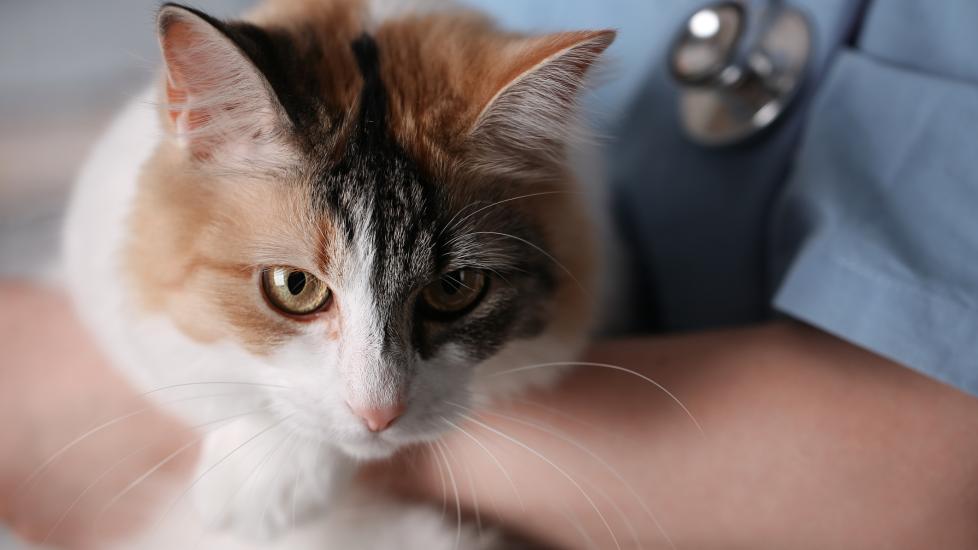Osteochondrodysplasia in Cats
What Is Osteochondrodysplasia in Cats?
Osteochondrodysplasia, or Scottish Fold disease (SFOCD), is a genetic mutation found in the Scottish Fold breed of cat. This mutation affects cartilage development and causes the breed’s classic appearance of having forward-folded ears.
The gene, termed the Fd gene, is autosomal dominant, which means only one copy of the gene is needed to cause disease. When cats carry two copies of the gene, the genetic defect leads to abnormalities in the bones during the growth phase, which causes severe lameness, pain, and progressive arthritis.
It also affects the kitten’s normal playful behaviors of jumping and playing, leading to a poor quality of life. These cats also develop symptoms much sooner and at an earlier age, whereas cats with only one copy of the gene will develop arthritis at a slower rate.
As there is no cure, SFOCD in cats is not considered a medical emergency. However, as the symptoms can be quite disabling and painful, seek veterinary care for your cat if you suspect they have the disease.
Symptoms of Osteochondrodysplasia in Cats
Symptoms are related to the amount of bone damage, and some cats may not have any symptoms or minor ones. However, the majority of affected cats will show the following, all of which can worsen with time:
-
Reluctance to move or jump
-
Vocalization during exercise
-
Abnormal posture or walk
-
Lameness, often appearing worse in the hindlimbs
-
Skeletal deformities: misshaped bones and joints; shortened and thicker tail; thickened feet, often with the toes spread wide
-
Decreased joint flexibility and fused bones/joints (ankylosis)
-
Reclusive behavior
-
Poor grooming behavior
Causes of Osteochondrodysplasia in Cats
Osteochondrodysplasia is an inherited condition, meaning one or both parents have a gene that causes the condition.
It's only seen in Scottish Fold cats—hence the name Scottish Fold disease—as the breed characteristic of having folded ears is due to the same gene mutation that causes this disease.
How Veterinarians Diagnose Osteochondrodysplasia in Cats
As an inherited disease, symptoms arise soon after birth in the Scottish Fold cat. Identification of the patient, often including age, gender, and breed, along with physical exam findings are signs that the veterinarian is dealing with a cat affected by osteochondrodysplasia.
X-rays, however, are used to diagnose the condition, looking for the various bone anomalies noted above as well as signs of arthritis.
Treatment of Osteochondrodysplasia in Cats
Unfortunately, there is no cure for Scottish Fold disease in cats. A combination of pain medications such as gabapentin; NSAIDs such as Onsior® or meloxicam; or a newer medication, Solensia™, a monoclonal antibody that targets nerve growth factor (an important factor in pain and swelling), can work to limit pain and minimize the progression of symptoms. Radiation therapy, which helps to alleviate pain, may also be an option.
Long-term therapies are often unrealistic, however, as the side effects of these medications can be severe, and symptoms can stop responding to medical management over time. At this point, humane euthanasia may be chosen.
While getting therapy, it’s important to keep your cat comfortable and manage their pain properly. Of course, this means a good partnership with your vet, sticking to proper recheck recommendations, and following through with blood work and other testing as needed.
Depending on the circumstances, there can be certain at-home measures you can take to help keep your cat comfortable, such as:
-
Providing multiple sources of comfortable bedding material
-
Placing food and water bowls in an accessible area on the floor
-
Blocking off access to stairs or pools
-
Keeping the floor free from clutter
-
Keeping your cat indoors
-
Applying padding to sharp edges and corners
Recovery and Management of Osteochondrodysplasia in Cats
Even though there is no true cure for SFOCD, the condition can be managed. In addition to prescription medications, over-the-counter products—such as joint supplements and chondroprotective agents to help reduce pain, minimize cartilage damage and swelling, increase joint lubrication, and help with cartilage production—can be recommended. A few of the many products available are Dasuquin®, Glycoflex®, or Cosequin®.
Also, diets with higher amounts of glucosamine, chondroitin sulfate, omega-3 and -6 fatty acids, and MSM could help. Talk with your vet about the best supplements and diet recommendations for your cat based on his unique medical and nutritional needs.
Finally, it’s important to follow your vet’s follow-up guidelines and continue all medications and diet as recommended. Many will be needed for the rest of your cat’s life.
Prevention of Osteochondrodysplasia in Cats
This condition can be prevented if ethical breeding standards are upheld. Cats with the condition and those who are carriers should not be used for breeding because of the potential for passing it on to their kittens.
However, once inherited, there is nothing you as a pet parent can do to prevent your cat from developing symptoms.
It’s important to seek treatment right away if something is wrong, so steps can be taken to minimize pain and slow the progression of the disease. Additionally, telling the veterinary staff of your cat’s ongoing condition is important so that any medications or future treatments can be given or performed as safely as possible.
Osteochondrodysplasia in Cats FAQs
Do all Scottish Fold cats have osteochondrodysplasia?
To an extent, yes; some Scottish Fold cats, however, will only develop minor symptoms while others can be affected so severely that their quality of life gets worse.
Is there a test for osteochondrodysplasia in cats?
Unfortunately, there is not a straightforward way to test for this condition, but with recent advances in genomic technology, it's possible that there will be a test for this condition in the near future.
Featured Image: SIBAS_minich/iStock / Getty Images Plus via Getty Images
